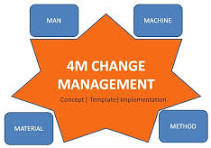4M Change have occasionally been supplemented with additional Ms over time. Whether to show how the tool has evolved or improved, Most manufacturers deal with at least one of these typical agility-related obstacles. The good news is that none of them—not even the ones related to aging capital equipment—are insurmountable. Hundreds of businesses have benefited from Performance Solutions by Milliken’s assistance in overcoming these challenges, which has significantly increased plant agility and enhanced operational excellence. How? by putting best practices—machines, labor, methods, and material—that address the four Ms of manufacturing into practice.
Why the 4M Work
We are aware that complexity can occasionally be employed to give the impression of depth or worth, but frequently the most basic tools are those that help us in our quest to enable every associate to confidently handle problems within their business. As the front line of operations, we can use these techniques to solve the problems they encounter.
We still find this to be true, even if it can be difficult to accept when a company has spent a lot of time and money on more sophisticated equipment and highly qualified people.
4M Change of manufacturing is one such instrument; most of the firms we interact with have some understanding of the idea. The fundamental definition is there, regardless of whether they refer to it as the 4Ms, 5Ms, 6Ms, Cause and Effect analysis, Fishbone diagram, or Ishikawa.
The effectiveness of this straightforward strategy in resolving operational issues through the discovery and elimination of the root cause(s) by individuals closest to the issues at the time and location of the issues is frequently surprising to many.

• Human: Ability, Technology, Structure, and Materials
Do our colleagues possess the knowledge, abilities, and motivation to carry out tasks in a safe, reliable, and efficient manner?
Machine (Equipment)
Method (Process, Schedule, Procedure)
Do we employ standard operating procedures that guarantee and facilitate reliable, secure production?
Material (data, supplies, consumables, and quality)
Are they free from flaws and shortages, and do they fulfill the necessary specifications? Is there little or no unnecessary handling or movement? Are they kept in the right storage?
The 4Ms give us a methodical framework for conducting root cause analysis, which enables us to comprehend the potential contributions of each to a given problem.
All of our Total Productive Maintenance pillars include 4M thinking to some degree, however it is most frequently applied as a root cause analysis technique. The framework it provides for locating sources of variation, issues’ underlying causes, or chances for change is priceless as a fundamental component of problem solving.
Safety:- Within the safety subcommittees, the 4Ms contribute to finding chances for improvement and underlying reasons.
Focused Improvement:-Within the analyze stage of our conventional DMAIC (Define, Measure, Analyze, Improve, Control) architecture for targeted improvement, we use 4Ms to assist organize the team’s thinking.
The pillars working together guarantees variation is reduced across all 4Ms, of course, much as a TPM implementation depends on leveraging people, process, and leadership working together. In fact, there is rarely a case where you cannot trace a relationship from each pillar to all 4 of the Ms.
4M Analysis
A technique for determining which of the 4M Change conditions is in charge of a defect mode is the 4M analysis. The Fishbone / Ishikawa Diagram is the most used. This tool’s purpose is to locate, investigate, and visually represent any potential reasons associated with an issue or state. With this method, teams can concentrate on the problem’s content, capture the group’s consensus and collective knowledge, and concentrate on the source rather than the symptom.
Significant operations gains are typical at Milliken & Company and other businesses led by Performance Solutions. Manufacturers in a variety of industries, including automotive, chemical, aerospace, food and beverage, consumer-packaged goods, paperboard and packaging, plastics and rubber, etc., have discovered untapped potential and agile capabilities within their organizations through operational excellence consulting from the Milliken Performance System, the implementation of the daily management practices that support it, Zero Loss Thinking to prioritize improvement projects, and an emphasis on culture change and employee empowerment.

